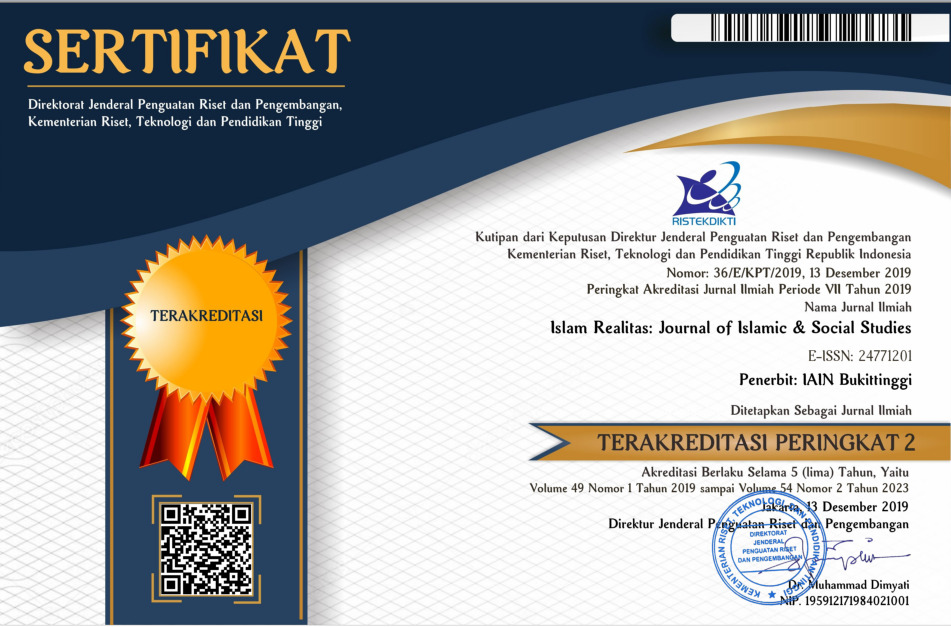The Digital Public Sphere and Muslim Piety in Aceh: Rethinking Habermas Conception of Communicative Action
Downloads
This study offers insights into the transformation of social media platforms as an alternative to the digital public sphere for Muslim society in Aceh. The communicative action theory by Habermas is used as approach to respond to this challenge. Descriptive quantitative analyses were used to expose religious discourse about Islam amongst young Muslims in Aceh. The results show that WhatsApp has proven to be the most popular among social media platforms. WhatsApp has functioned as a new public sphere for Muslim society in Aceh and has evolved into an essential part of mediated Islamic discourse in the digital era. In this regard, WhatsApp has created a universal public sphere, available to Muslim society as dialogic communication in Aceh. This research concludes that the Muslims in Aceh are not merely users of WhatsApp. They can also be digital preachers who can build individual narratives as a part of the religious struggle to increase their piety.
Kajian ini dilakukan untuk memberikan pemahaman mendalam tentang bagaimana transformasi platform media sosial sebagai alternatif ruang publik digital pada masyarakat Muslim di Aceh. Teori tindakan komunikatif Habermas digunakan sebagai pendekatan untuk menjawab tantangan ini. Analisis deskriptif kuantitatif digunakan untuk mengekspos diskursus keagamaan Islam di kalangan generasi muda Muslim di Aceh melalui lanskap media sosial baru yang lebih kontemporer. Hasilnya menunjukkan bahwa WhatsApp telah terbukti menjadi media yang paling populer di antara banyak platform media sosial. WhatsApp telah memberikan manfaat sebagai alternatif ruang publik baru bagi masyarakat Muslim di Aceh dan telah berkembang menjadi bagian penting dalam perkembangan diskursus keislaman di era digital. Dalam hal ini, WhatsApp telah menciptakan ruang publik yang universal, tersedia bagi Muslim sebagai satu bentuk komunikasi dialogis di Aceh. Penelitian ini menyimpulkan bahwa umat Islam di Aceh bukan hanya pengguna WhatsApp saja. Namun, mereka juga menjadi penceramah digital yang dapat membangun narasi individu yang dipilih sebagai bagian dari perjuangan dakwah untuk meningkatkan ketakwaannya
Books
Asad, Talal. Formations of the Secular. Stanford University Press, 2020
Calhoun, Craig, ed. Habermas and The Public Sphere. MIT Press, 1993
Habermas, Jürgen. Communication and the Evolution of Society. Beacon Press, 1979.
----------. The Theory of Communicative Action: Jurgen Habermas; Trans. by Thomas McCarthy. Heinemann, 1984.
---------. "The theory of communicative action (vol. 2): System and lifeworld." Cambridge: Polity (1987).
---------. The structural transformation of the public sphere: An inquiry into a category of bourgeois society. MIT press, 1991.
----------, Jacques Derrida, and Giovanna Borradori. Philosophy in a time of terror: Dialogues with Jurgen Habermas and Jacques Derrida. University of Chicago Press, 2003.
---------. "Interview with Jürgen Habermas." The Oxford handbook of deliberative democracy. 2018.
--------. Autonomy and solidarity: interviews with Jürgen Habermas. Verso, 1992.
Pusey, Michael. Jurgen habermas. Routledge, 2002.
Journals
Alam, Lukis. "Islamization, Piety, Fundamentalism: Religious Movement In Campus." Islam Realitas: Journal of Islamic and Social Studies 4.2 (2018): 104-120.
Akmaliah, Wahyudi. "The demise of moderate Islam: new media, contestation, and Reclaiming religious authorities." Indonesian Journal of Islam and Muslim Societies 10.1 (2020).
Bhakti, Sufri Eka. "Exposure to Da'wah Message among Young Social Media Users in Aceh: A Reflection of Habermas's Communicative Action." Jurnal Komunikasi Islam 10.2 (2020): 217-234.
Bhakti, Sufri Eka. "Ruang publik dan media sosial: partisipasi politik mahasiswa indonesia." Jurnal Kajian Media 4.1 (2020).
Bruns, Axel, and Tim Highfield. "Social media
and the public sphere." The Routledge
companion to social media and politics (2015): 56-74.
.Casanova, José. "Rethinking secularization: A
global comparativperspective." Religion, globalization, and culture. Brill, 2007. 101-120.
Dhuhri, Saifuddin, and Tarmizi Jakfar. "MÄturÄ«dite Kalam among Southeast Asian Asharite: A Synthesis of MÄturÄ«dite Influences on Dayah's Theology." Al-Jami'ah: Journal of Islamic Studies 58.2 (2020): 391-418.
Eickelman, Dale F., and Armando Salvatore. "The public sphere and Muslim identities." European Journal of Sociology/Archives Européennes de Sociologie 43.1 (2002): 92-115.
Habermas, Jurgen. "Reconciliation through the public use of reason: remarks on John Rawls's political liberalism." The journal of philosophy 92.3 (1995): 109-131.
-----------. "Habermas: Questions and counterquestions." PraxisInternational 4.3 (1984): 229-249.
Hakim, Fany Nur Rahmadiana, Ihsan Kamaludin, and Shifa Nisrina Sujana. "The New Da’wah Strategy among Millennial Generations through Tiktok During Pandemic." Islam Realitas: Journal of Islamic and Social Studies 7.2 (2021): 167-180.
Hasanuddin, Muhammad Irfan. "Female Ulama: Mediating Religious Authority In A Limited ‘Islamic’public Sphere In Contemporary Indonesia." Islam Realitas: Journal Of Islamic And Social Studies 4.2 (2018): 189-210.
Hendri, Novi, and Hardi Putra Wirman. "The
Radical Islamic Movements in West Sumatra: An Early Investigation and Mapping." Islam Realitas: Journal of Islamic and Social Studies 6.1 (2020): 100-118.
Lafont, Cristina. "Religion in the public sphere:
remarks on Habermas's conception of
public deliberation in postsecular societies." Constellations-Oxford- 14.2 (2007): 239.
Muna, Afrida Arinal. "Religious Expression of Hijrah Celebrity: Accommodating Protest and Political Economy of Public Piety." Islam Realitas: Journal of Islamic and Social Studies 6.1 (2020): 90-99.
Omar, Faradillah Iqmar, Nor Azlili Hassan, and Iza Sharina Sallehuddin. "Role of Social Media in Disseminating Dakwah (Peranan Media Sosial dalam Penyebaran Dakwah)." Islamic perspectives relating to business, arts, culture and communication. Springer, Singapore, 2015. 43-55.
Parhan, Muhamad, et al. "Responding to Islamophobia by Internalizing the Value of Islam Rahmatan Lil Alamin through Using the Media." Islam Realitas: Journal of Islamic and Social Studies 6.2 (2020): 137-149.
Qodir, Zuly. "Public sphere contestation: configuration of political Islam in contemporary Indonesia." Indonesian Journal of Islam and Muslim Societies 1.1 (2011): 123-149.
Rohmatulloh, Dawam Multazamy, and Asna Istya Marwantika. "Contesting# IslamNusantara on Instagram: A Shared Interest Pool." Wawasan: Jurnal Ilmiah Agama dan Sosial Budaya 6.2 (2021): 101-114.
Online Resources
Global Social Media Research Summary 2020.
(2020). Taken on 7 September 2020, From Smart Insights Website: https://www.smartinsights.com/social-media-marketing/
Copyright (c) 2022 Sufri Eka Bhakti, Saifuddin Dhuhri

This work is licensed under a Creative Commons Attribution-ShareAlike 4.0 International License.
Authors who publish with this journal agree to the following terms:
- Authors retain copyright and grant the journal right of first publication with the work simultaneously licensed under a Creative Commons Attribution License that allows others to share the work with an acknowledgment of the work's authorship and initial publication in this journal.
- Authors are able to enter into separate, additional contractual arrangements for the non-exclusive distribution of the journal's published version of the work (e.g., post it to an institutional repository or publish it in a book), with an acknowledgment of its initial publication in this journal.
- Authors are permitted and encouraged to post their work online (e.g., in institutional repositories or on their website) prior to and during the submission process, as it can lead to productive exchanges, as well as earlier and greater citation of published work (See The Effect of Open Access).









